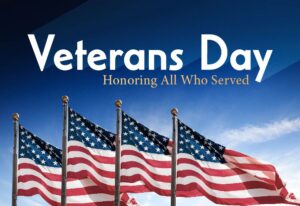 Many Americans mistakenly believe that Veterans Day is the day America sets aside to honor American military personnel who died in battle or as a result of wounds sustained from combat. That’s not quite true. Memorial Day is the day set aside to honor America’s war dead.
Many Americans mistakenly believe that Veterans Day is the day America sets aside to honor American military personnel who died in battle or as a result of wounds sustained from combat. That’s not quite true. Memorial Day is the day set aside to honor America’s war dead.
Veterans Day, on the other hand, honors ALL American veterans, both living and dead. In fact, Veterans Day is largely intended to thank LIVING veterans for dedicated and loyal service to their country. November 11 of each year is the day that we ensure veterans know that we deeply appreciate the sacrifices they have made in the lives to keep our country free.
To commemorate the ending of the “Great War” (World War I), an “unknown soldier” was buried in highest place of honor in both England and France ( (in England, Westminster Abbey; in France, the Arc de Triomphe). These ceremonies took place on November 11th, celebrating the ending of World War I hostilities at 11 a.m., November 11, 1918 (the 11th hour of the 11th day of the 11th month). This day became known internationally as “Armistice Day”.
In 1921, the United States of America followed France and England by laying to rest the remains of a World War I American soldier — his name “known but to God” — on a Virginia hillside overlooking the city of Washington DC and the Potomac River. This site became known as the “Tomb of the Unknown Soldier,” and today is called the “Tomb of the Unknowns.” Located in Arlington National Cemetery, the tomb symbolizes dignity and reverence for the American veteran.
In America, November 11th officially became known as Armistice Day through an act of Congress in 1926. It wasn’t until 12 years later, through a similar act that Armistice Day became a national holiday.
The entire World thought that World War I was the “War to end all wars.” Had this been true, the holiday might still be called Armistice Day today. That dream was shattered in 1939 when World War II broke out in Europe. More than 400,000 American service members died during that horrific war.
Veterans Day
In 1947, Raymond Weeks, of Birmingham Ala., organized a “Veterans Day” parade on November 11th to honor all of America’s veterans for their loyal and dedicated service. Shortly thereafter, Congressman Edward H. Rees (Kansas) introduced legislation to change the name of Armistice Day to Veterans Day in order to honor all veterans who have served the United States in all wars.
In 1954, President Eisenhower signed a bill proclaiming November 11 as Veterans Day, and called upon Americans everywhere to rededicate themselves to the cause of peace. He issued a Presidential Order directing the head of the Veterans Administration (now called the Department of Veterans Affairs), to form a Veterans Day National Committee to organize and oversee the national observance of Veterans Day.
Congress passed legislation in 1968 to move Veterans Day to the fourth Monday in October. However as it became apparent that November 11th was historically significant to many Americans, in 1978, Congress reversed itself and returned the holiday to its traditional date.
Veterans Day National Ceremony
At exactly 11 a.m., each November 11th, a color guard, made up of members from each of the military branches, renders honors to America’s war dead during a heart-moving ceremony at the Tomb of the Unknowns in Arlington National Cemetery.
The President or his representative places a wreath at the Tomb and a bugler sounds Taps. The balance of the ceremony, including a “Parade of Flags” by numerous veterans service organizations, takes place inside the Memorial Amphitheater, adjacent to the Tomb.
In addition to planning and coordinating the National Veterans Day Ceremony, the Veterans Day National Committee supports a number of Veterans Day Regional Sites. These sites conduct Veterans Day celebrations that provide excellent examples for other communities to follow.
Veterans Day Observance
Veterans Day is always observed on November 11, regardless of the day of the week on which it falls. The Veterans Day National Ceremony is always held on Veterans Day itself, even if the holiday falls on a Saturday or Sunday. However, like all other federal holidays, when it falls on a non-workday — Saturday or Sunday — the federal government employees take the day off on Monday (if the holiday falls on Sunday) or Friday (if the holiday falls on Saturday).
Federal government holiday observance (for federal employees, including military) is established by federal law. 5 U.S.C. 6103 establishes the following public holidays for Federal employees: New Year’s Day, Birthday of Martin Luther King, Jr., Washington’s Birthday (President’s Day), Memorial Day, Independence Day, Labor Day, Columbus Day, Veterans Day, Thanksgiving Day, and Christmas Day.
This federal law does not apply to state and local governments. They are free to determine local government closings (including school closings) locally. As such, there is no legal requirement that schools close of Veterans Day, and many do not. However, most schools hold Veterans Day activities on Veterans Day and throughout the week of the holiday to honor American veterans.
Have You Hugged Your Veteran Today?
One of the most personal and meaningful Veterans Day activities for people is to send notes or cards to hospitalized veterans or those living in veterans homes. Or, better yet, visit a veteran in a local veterans hospital or veterans home. The best way to have a “happy Veterans Day” is to do something special to make a veteran happy



